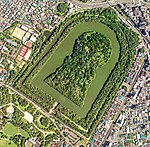
Kengoshizuka Kofun is a Kofun in Asuka, Nara Japan.[1][2] Specifically, it is an Octagonal Kofun. It is said to be the burial site of Empress Kōgyoku.[3][4] it was reconstructed and opened to the public on May 6 2022.[4] This contrasts with other Imperial tombs such as the Mausoleum of Emperor Tenji which are closed to the public by the Imperial Household Agency.[5]

References
- ^ Tokuse, Takahiko, and Eriko Oka. "Life in Archaeological Sites and Settlements in Asuka Village as a Model Case for Managing Settlements Adjacent to Archaeological Sites: A Proposal for the Future of Saqqara." The journal of Center for the Global Study of Cultural Heritage and Culture 2 (2015): 5-20.
- ^ "Burial Mounds in Europe and Japan: Comparative and Contextual Perspectives". 30 September 2018. doi:10.2307/j.ctv1228gf7. S2CID 240193791.
{{cite journal}}: Cite journal requires|journal=(help) - ^ "Kengoshizuka Kofun Tumulus, Koshitsuka-gomon Kofun Tumulus". Exploring the Footsteps of the Heroines of Asuka. Retrieved 2023-10-20.
- ^ a b "Octagonal burial mound said to belong to ancient Japan empress reconstructed in Nara Pref". Mainichi Daily News. 2022-03-04. Retrieved 2023-10-20.
- ^ "Gobyōyama Kofun (in Kyōto) - Passage Grave in Japan in Honshū". The Megalithic Portal. Retrieved 2023-10-21.

